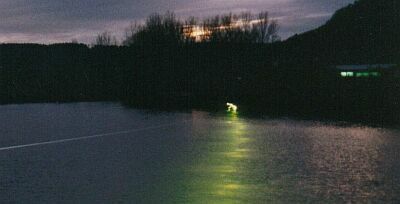
Deflecting eels from water intakes with light
M.C.M. Bruijs, R.H. Hadderingh and H.A. Jenner
KEMA Power Generation & Sustainables, KEMA Nederland bv, Arnhem, The Netherlands
Fish migrating downstream suffer mortality by passing through the turbines of hydroelectric power stations. There is currently high concern for the European eel Anguilla anguilla, a migratory catadromous species, because of the large decline in its population over recent decades. In Europe, mortality rates of migrating silver eels at hydropower stations may reach 40%. Eels are particularly sensitive to damage due to their large length. Other factors contributing to their mortality are the flow rate and the type of turbine.
In order to reduce this mortality substantially, KEMA has developed behavioral deflection methods based on light, to guide the eels through a safe bypass [1,2,3]. With respect to the development of a suitable light deflection method at water intakes, two behavioral characteristics of eel are very important. First, eels are negatively phototactic. They are nocturnal predators, and prefer to burrow in bottom sediment during the day. The downstream migration of silver eels takes place almost completely during the night [4]. Second, eels are strongly attracted to water currents. The preference of migrating eels for areas with the highest current might be a tactic to save energy, since the amount of active swimming is reduced and a shorter migration period is required to reach the sea [5].
During recent years, KEMA has performed a variety of laboratory and field experiments with light systems. Several light sources (incandescent, mercury, fluorescent and strobe lights) with different spectra heve been tested. Eels showed a clear avoidance reaction to light in laboratory flume experiments, and in field experiments at different locations. Deflection rates of up to 74% were reached at water intakes of thermal and hydropower stations. An essential feature to the efficiency of a light deflection system is a bypass facility with optimal attraction flow. Laboratory experiments indicated that eels are strongly attracted towards higher water velocities.
These results encourage the installation of light-induced deflection systems at hydropower stations to reduce eel mortality.

Figure 1. Light barrier at hydrapower water intake.
References
Paper presented at Measuring Behavior 2002 , 4th International Conference on Methods and Techniques in Behavioral Research, 27-30 August 2002, Amsterdam, The Netherlands